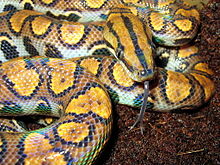- Epicrates (genus)
-
Epicrates 
Brazilian rainbow boa, E. c. cenchria Scientific classification Kingdom: Animalia Phylum: Chordata Subphylum: Vertebrata Class: Reptilia Order: Squamata Suborder: Serpentes Family: Boidae Subfamily: Boinae Genus: Epicrates
Wagler, 1830Synonyms - Epicrates - Wagler, 1830
- Chilabothrus - A.M.C. Duméril & Bibron, 1844
- Cliftia - Gray, 1849
- Epicarsius - Fischer, 1856
- Homalochilus - Fischer, 1856
- Piesigaster - Seoane, 1881
- Epicrates - Boulenger, 1893
- Boella - H.M. Smith & Chiszar, 1992[1]
- Common names: Greater Antillean boas, rainbow boas, West Indian boas.[2]
Epicrates is a genus of non-venomous boas found in South America, Central America and the West Indies. Ten species are currently recognized.[2]
Contents
Geographic range
Found in lower Central America through South America as far south as Argentina, as well as in the West Indies.[1]
Species
Species[2] Taxon author[2] Subsp.*[2] Common name Geographic range[1] E. angulifer Bibron, 1840 0 Cuban boa[2] Cuba and adjacent islands, including Isla de la Juventud, the Archipiélago de los Canarreos (Cayo Cantiles), the Archipiélago de los Colorados off the northern coast of Pinar del Río, the Archipiélago de Sabana-Camagüey (Cayo Guajaba and Cayo Sant María). Also found in the Bahamas. E. cenchriaT (Linnaeus, 1758) 8 Rainbow boa[2] Lower Central America in Costa Rica and Panama. South America east of the Andes in Colombia, Venezuela, Guyana, Suriname, French Guiana, Brazil, Ecuador, Peru, Bolivia, Paraguay and northern Argentina (in the provinces of Chaco, Córdoba, Corrientes, Formosa, Salta, Santiago del Estero and Tucumán). E. chrysogaster (Cope, 1871) 2 Turks & Caicos Island boa West Indies, including the Turks Islands (Grand Turk Island uncertain), the Caicos Islands (Middle Caicos, North Caicos, Big Ambergris Cay, Little Ambergris Cay and Long Cay) and likely other parts of the Turks and Caicos Islands. The Bahamas, including Acklins and Crooked Islands, Great Inagua Island and Sheep Cay. E. exsul Netting & Goin, 1944 0 Abaco Island boa The Bahamas: Grand Bahama Island and Great Abaco Island, including Elbow Cay and Little Abaco Island. E. fordii (Günther, 1861) 2 Haitian ground boa Hispaniola and adjacent islands, including Île de la Gonâve, Isla Saona and Île à Cabrit. E. gracilis (Fischer, 1888) 1 Haitian tree boa Hispaniola, north of the Cul de Sac. According to Sheplan & Schwart (1974), on the Valle de Neiba plain. E. inornatus (Reinhardt, 1843) 0 Puerto Rican boa[2] Puerto Rico. E. monensis Zenneck, 1898 1 Mona boa[2] West Indies: Mona Island and Cayo Diablo near Puerto Rico. The U.S. and British Virgin Islands: St. Thomas, Tortola, Great Camanoe, Necker and Virgin Gorda. E. striatus (Fischer, 1856) 7 Hispaniolan boa Hispaniola and adjacent islands, including Île de la Tortue, Isla Saona and Île à Vache. The Bahamas: Andros Island, Berry Island (including Chub Cay and Great Harbour Cay), Booby Cay (near onception Island), Cat Island (including Alligator Cay). The Bimini Islands, including East Bimini Island, Easter Cay, North Bimini Island and South Bimini Island. Eleuthera and Long Island. The Exuma Cays, including Compass Cay and Great Exuma Island. New Providence Island, including Rose Island. Ragged Island, including Margaret Cay and Little Ragged Cay. E. subflavus Stejneger, 1901 0 Jamaican boa[2] Jamaica, including Goat Island. *) Not including the nominate subspecies.
T) Type species.[1]See also
- List of boine species and subspecies
- Boinae by common name
- Boinae by taxonomic synonyms
References
- ^ a b c d McDiarmid RW, Campbell JA, Touré T. 1999. Snake Species of the World: A Taxonomic and Geographic Reference, vol. 1. Herpetologists' League. 511 pp. ISBN 1-893777-00-6 (series). ISBN 1-893777-01-4 (volume).
- ^ a b c d e f g h i j "Epicrates". Integrated Taxonomic Information System. http://www.itis.gov/servlet/SingleRpt/SingleRpt?search_topic=TSN&search_value=174327. Retrieved 6 July 2008.
External links
- Epicrates at the Reptarium.cz Reptile Database. Accessed 6 July 2008.
Categories:- Boinae
- Fauna of Guyana
Wikimedia Foundation. 2010.
